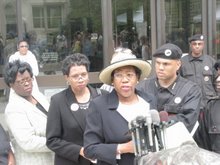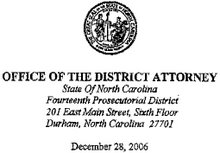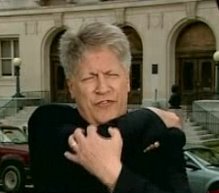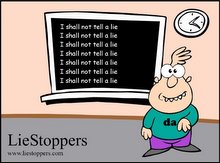Himan and the Fourth Amendment
As if additional demonstration of the Durham police department's disregard for the law and constitutional rights was required to magnify the need for a Department of Justice investigation into the Nifong/Mangum Hoax, a review of DPD Investigator Benjamin Himan's case notes reveals that the Durham Police Department's illegal acts were not limited to the assault on the Duke lacrosse team.The right of the people to be secure in their persons, houses, papers, and effects, against unreasonable searches and seizures, shall not be violated, and no Warrants shall issue, but upon probable cause, supported by Oath or affirmation, and particularly describing the place to be searched, and the persons or things to be seized.
In obtaining consent for DNA testing from two witnesses, Blake Boehmler and Brent Saeli, Inv. Himan repeatedly threatened to obtain an illegal non-testimonial identification order and hinted that the media would publicize the names of the witnesses seemingly as suspects in the alleged gang rape of false accuser Crystal Mangum. Himan's unconstitutional threats followed the admission by at least one of the witnesses that they feared the consequences of such public exposure the investigator held over his head.
Himan's coercion came at a time when he had already secured the indictment of two innocent men and had his sights firmly on a third innocent suspect whose indictment he would obtain only days after his threats and several weeks before those threats against the equally innocent witnesses would prove fruitful. In the non-crime, the two witnesses were not suspects, as evidenced by Himan's Grand Jury testimony against the three other innocent men, yet the investigator threatened to expose them to the media as such if they did not comply with his demand.
5/9/06 - Spoke to Mr. Egan. I asked if he represented Mr. Boehmler and he stated yes. I stated that I needed to get a buccal swabbing, I stated I had not been in contact with him for a couple of weeks and was advised to talk to you about the matter. I stated that Mr. Boehmler was being cooperative and didn’t want his name in the papers. I stated that I know if I had a NTO that the press would get a hold of it and that Mr. Boehmler I did not think wanted that kind of attention. Mr. Egan stated he would try to get a hold of him.With his coercive threats, Inv. Himan violated the witnesses Fourth Amendment rights by threatening to obtain a non-testimonial identification order that, by law, could not be acquired against non-suspects; by falsely suggesting that he had the authority to obtain the NTO rather than acknowledging that he could only request that the order be issued; by not informing the witnesses that they could refuse his request; and by threatening media exposure.
5/9/06 1433hrs - Spoke to Mr. Egan. Mr. Egan stated that he not been in touch with Blake. I stated to Mr. Egan that if it was going to be voluntarily, then it needed to be done in the next two weeks. I would then move to have a NTO done if they were not going to come in voluntarily. Mr. Egan stated he would relay the information to Mr. Saeli and would contact me back.
As with other constitutional protections, Fourth Amendment rights may be waived if a person voluntarily consents to a warrant-less search. In Bumper v North Carolina, however, the Supreme Court noted:
“When a law enforcement officer claims authority to search a home under a warrant, he announces in effect that the occupant has no right to resist the search. The situation is instinct with coercion-albeit colorable lawful coercion. Where there is coercion there cannot be consent.”
In State v. Williams, the Supreme Court of West Virginia wrote:
Based upon the facts in this case, we have little hesitancy in finding that Mr. McClead did not voluntarily consent to the blood test. Trooper Branham did not inform Mr. McClead that he had a right to refuse the blood test and that if he did so the blood test could not be administered against his will. Instead, Mr. McClead was mislead and misinformed by Trooper Branham. Mr. McClead was advised that blood could be taken from him against his will through the use of a search warrant. The record is clear that it was only because of this subtle coercion that Mr. McClead consented to the blood test. See Bumper v. North Carolina, 391 U.S. 543, 550, 88 S.Ct. 1788, 1792, 20 L.Ed.2d 797 (1968) (“When a law enforcement officer claims authority to search . . . under a warrant, he announces in effect that the [defendant] has no right to resist the search. The situation is instinct with coercion--albeit colorably lawful coercion. Where there is coercion there cannot be consent.”).In an article for the Journal of the DuPage County Bar Association, Stephen A. Brundage notes: "Illinois courts apply the Bumper holding when addressing consent searches."
Mr. McClead was given incomplete and inaccurate information regarding the consequences of his refusal to take the blood test. We cannot find that his consent to the blood test was voluntary as it was clearly secured by use of a coercing threat to obtain a search warrant. “We, therefore, are constrained to hold, considering the totality of the circumstances, that [Mr. McClead] did not freely and voluntarily consent to the [blood test], and that the trial court erred in admitting the [blood test results] into evidence.” State v. Williams, 162 W. Va. 309, 317, 249 S.E.2d 758, 764 (1978).
The law of consensual searches is defined in the United States Supreme Court case of Bumper v. North Carolina
...
In People v. Bailey, 273 Ill.App.3d 431, 652 N.E.2d 1084, 210 Ill.Dec. 430 (1st Dist. 1995), DEA Agents informed an individual that unless he allowed them to search his bag, they would obtain the help of a narcotics detector dog to sniff the bag and would detain the defendant to do so. The defendant was very nervous throughout the questioning and his hands were shaking and his "whole body was trembling." Id. at ___, 652 N.E.2d at 1085, 210 Ill.Dec. at ___. The Bailey court stated,[The agent’s] threat that he intended to detain defendant’s bags falsely implied that he could do so legally; thus from that point on, defendant was constrained to labor under "an erroneous belief" that he could not protect his privacy by refusing to give consent... No matter how defendant responded to the threat, the agent was going to take his bags from him. Consequently, we conclude that the agent’s threat was ‘instinct with coercion;’ therefore defendant’s consent can in no way be characterized as voluntary. Id. at ___, 652 N.E.2d at 1088, 210 Ill.Dec. at ___.
The Court then applied a test, which examined whether or not the officers had actual grounds to carry out that the threat of detention and summoning of a narcotics detector dog and determined that the actual grounds to detain the defendant were lacking. Thus, the police officers violated the Fourth (4th) Amendment because the defendant did not give voluntary consent to search his bag.
In an update for prosecutors and police, the Clark County (IN) Prosecutors Office cites a State Appellate Court ruling in cautioning careful wording when threatening to obtain warrants as a means to coerce compliance with requests for consent searches.
The law is clear that when a person consents to a search, that consent is not valid unless it is voluntary, and voluntariness is determined by examining the totality of the circumstances. While the law is not crystal clear, it appears to be a strongly negative circumstance that the officer seeking the consent advises the person whose consent is sought that a search warrant would be obtained, rather than merely sought, if consent was not given. The Court of Appeals ruled recently that this rendered a choice illusory and invalidates a subsequent consent. The person is merely acquiescing to the officer's claim of lawful authority. State v. Barber, 739 N.E.2d 192 (Ind. App. 2000).
In an article entitled "SEARCHING FOR A NEEDLE IN A HAYSTACK: THE CONSTITUTIONALITY OF POLICE DNA DRAGNETS" which was published by the Chicago-Kent Law review, Sepideh Esmaili addresses a Louisiana case that mirrors Himan's coercion of Boehmler and Saeli.
Shannon Kohler was given a “choice” when he was approached by the Baton Rouge Police.
He could either allow the police to swab the inside of his mouth to analyze his DNA or he could refuse and, according to the police, be subjected to a court order and public speculation that he was a serial killer.
The police warned that the court order would most likely get Kohler’s name into the newspapers as being uncooperative in the investigation of the murders of four women and as a possible suspect in the crimes.
Kohler eventually provided a sample of his DNA to the police.
The irony of this situation was that Kohler was not even a suspect in the four murders.
He did not drive the type of car that witnesses saw at the scenes of the crimes, and he had phone records showing he was at home on the nights that the murders occurred.
The Baton Rouge Police, however, targeted Kohler and nearly 1,200 other men for DNA testing based on paltry connections to the victims, such as Kohler’s having once worked on the street on which the police found the first victim’s cell phone.
...
Although consent in the absence of probable cause or reasonable suspicion may render a search reasonable, the Supreme Court has held that the consent secured by police must be truly “voluntary” and not the product of coercion, express or implied.
...
In the case of DNA dragnets, however, consent given under coercive conditions where police threaten individuals with court orders and media scrutiny is not truly voluntary and thus is invalid.
The New York Times noted that the threat issued by the Baton Rouge police against Mr. Kohler was not an idle one.
In the end, Mr. Kohler, alone among 15 people who refused the DNA test, was indeed identified in public court documents, and hours later a local television reporter appeared at his front door. The police called the court filing a good-faith clerical mistake. The DNA test later cleared Mr. Kohler. And the killer is still at large.The threat of media exposure and a court order was not the only model the Baton Rouge police provided for Investigator Himan.
It appears that Investigator Himan also employed the same tactics in obtaining the NTO for the forty six Duke lacrosse team members as those which subjected Detective Christopher Johnson to civil liability for his actions against Kohler. When Mr. Kohler brought a lawsuit against the investigator who obtained the NTO by filing an affidavit containing false statements and omitting exculpatory information, the Fifth Circuit United States Court of Appeals ruled that the affidavit was lacking in probable cause as a result of the false statements and ordered the suit remanded for further proceedings.
Upon being served with the signed warrant by Detective Johnson, Kohler submitted to an oral saliva swab. Detective Johnson then filed the affidavit, the warrant, and the warrant return in the public records of the Clerk of Court for the Nineteenth Judicial District Court. Within a day, Kohler was identified by the media as a suspect in the serial killer investigation who was refusing to cooperate with police. Not until two months later did Kohler learn from a local newspaper that he had been cleared as a suspect because his DNA was not a match to that of the serial killer.
Kohler brought suit against Detective Johnson, Chief Englade, the City, the Parish of East Baton Rouge, and East Baton Rouge Parish Sheriff Elmer Litchfield,2 asserting that the taking of his DNA violated his rights under the Fourth and Fourteenth Amendments to the United States Constitution and Article I, Section 5 of the Louisiana Constitution. In his Complaint, Kohler alleged that the affidavit submitted by Detective Johnson to procure the seizure warrant did not provide probable cause to believe that Kohler was the serial killer and concealed from Judge Anderson exculpatory facts, namely, that Kohler was pardoned for his burglary conviction, that he had not worked in the area where the victim’s cell phone was found for over a decade, and that he could not have made the bloody footprint left at the crime scene. Accordingly, Kohler sought damages and the expungement of his DNA profile from any place where it had been stored.
...
Kohler first asserts that Detective Johnson violated his rights under the Fourth and Fourteenth Amendments by submitting to Judge Anderson an affidavit for a seizure warrant lacking in probable cause. A police officer seeking the issuance of a search warrant must present an affidavit containing facts sufficient to “provide the magistrate with a substantial basis for determining the existence of probable cause.” Illinois v. Gates, 462 U.S. 213, 239, 103 S. Ct. 2317, 76 L. Ed. 2d 527 (1983).
Probable cause exists when there are reasonably trustworthy facts which, given the totality of the circumstances, are sufficient to lead a prudent person to believe that the items sought constitute fruits, instrumentalities, or evidence of a crime. Id. at 238-39. The officer’s supporting affidavit must make it apparent, therefore, that there is some nexus between the items to be seized and the criminal activity being investigated. See Warden v. Hayden, 387 U.S. 294, 302, 307, 87 S. Ct. 1642, 18 L. Ed. 2d 782 (1967). Although we accord great deference to a magistrate’s determination of probable cause, we will not “defer to a warrant based on an affidavit that does not ‘provide the magistrate with a substantial basis for determining the existence of probable cause.’” United States v. Leon, 468 U.S. 897, 914-15, 104 S. Ct. 3405, 82 L. Ed. 2d 677 (1984) (quoting Gates, 462 U.S. at 239). Whether the facts set forth in Detective Johnson’s warrant affidavit provided probable cause for the seizure warrant is a question of law that we review de novo. See United States v. Runyan, 290 F.3d 223, 236-37 (5th Cir. 2002); Blackwell v. Barton, 34 F.3d 298, 305 (5th Cir. 1995).
...
Accordingly, we conclude that the district court erred in finding that the seizure warrant was supported by probable cause.
Kohler also contends that Detective Johnson violated his Fourth Amendment rights by omitting exculpatory information from the warrant affidavit, thereby precluding review by a neutral magistrate of all the facts material to the existence of probable cause. Pursuant to Franks v. Delaware, 438 U.S. 154, 98 S. Ct. 2674, 57 L. Ed. 2d 667 (1978), a Fourth Amendment violation may be established where an officer intentionally, or with reckless disregard for the truth, includes a false statement in a warrant application. Likewise, the intentional or reckless omission of material facts from a warrant application may amount to a Fourth Amendment violation. See Hale v. Fish, 899 F.2d 390, 400 n.3 (5th Cir. 1990).
... To determine whether facts omitted from a warrant affidavit are material to the determination of probable cause, courts ordinarily insert the omitted facts into the affidavit and ask whether the reconstructed affidavit would still support a finding of probable cause. See, e.g., United States v. Martin, 615 F.2d 318, 328 (5th Cir. 1980). This materiality analysis presumes that the warrant affidavit, on its face, supports a finding of probable cause. In cases such as this one, however, where the warrant affidavit is already lacking in probable cause, any reconstructed affidavit that includes the omitted exculpatory information would necessarily lack probable cause as well, regardless of the materiality of the omitted information. This result appears to dictate one of two competing conclusions: either that a prerequisite for a Franks violation is a warrant affidavit that appears to establish probable cause on its face; or that the usual test for materiality is simply not helpful to determining whether an officer’s omissions amounted to a constitutional violationwhenthe warrant affidavit is facially insufficient, and the materiality test should therefore be modified to encompass such claims.
We recognize that the former conclusion is, in essence, a conclusion that a plaintiff cannot hold an officer liable under Franks for intentionally omitting important exculpatory information from a warrant affidavit when the officer has also committed a Malley violation by presenting a facially deficient warrant affidavit to the issuing judge. We further recognize that the latter conclusion is not necessarily inconsistent with Franks, which protects against omissions that are designed to mislead, or that are made in reckless disregard of whether they would mislead, the issuing judge in making the probable cause determination. Nonetheless, it is clear that Franks itself was confined to providing a mechanism for challenging a search warrant that was not supported by probable cause but that, due to the inclusion of deliberately falsified allegations in the warrant affidavit, appeared to be supported by probable cause. The principles of Franks have never been applied to facially invalid warrants, and we decline to so extend Franks today. Because we have found that there was insufficient evidence to establish probable cause on the face of Detective Johnson’s warrant affidavit, we conclude that Franks is inapplicable. Accordingly, the district court did not err in granting summary judgment to Detective Johnson on Kohler’s Franks claim.
For the foregoing reasons, we vacate the district court’s grant of summary judgment on Kohler’s claim that Detective Johnson submitted to Judge Anderson a warrant affidavit lacking in probable cause; affirm the grant of summary judgment on Kohler’s claim that Detective Johnson submitted to Judge Anderson a warrant affidavit containing material omissions and on Kohler’s claims against Chief Englade and the City; and remand for further proceedings not inconsistent with this opinion..














































3 comments:
There is ample evidence of egregious violations of several Constitutional rights in this case, yet there is no indication that our every vigilant FBI is on the case. And neither of our US Senators has had the integrity to speak out and demand a federal inquiry. I guess things would be different if it was three black students being framed.
Could the DPD get an NTO for a suspect in May 2006 without disclosing that there was male DNA in/on CGM that did not belong to a LAX player or a boyfriend/driver of CGM, as part of the probable cause statement? If the NTO was issued, for Blake Boehmler and Brent Saeli as suspects, and with the Probable Cause stating that there was unidentified male DNA would that have finished the case?
Please note that my 4:53 post is not suggesting that Blake Boehmler and Brent Saeli should be thought of as suspects. The Attorney General of North Carolina has declared that there was no crime so no one is a suspect as NOTHING EVER HAPPENED!
Post a Comment